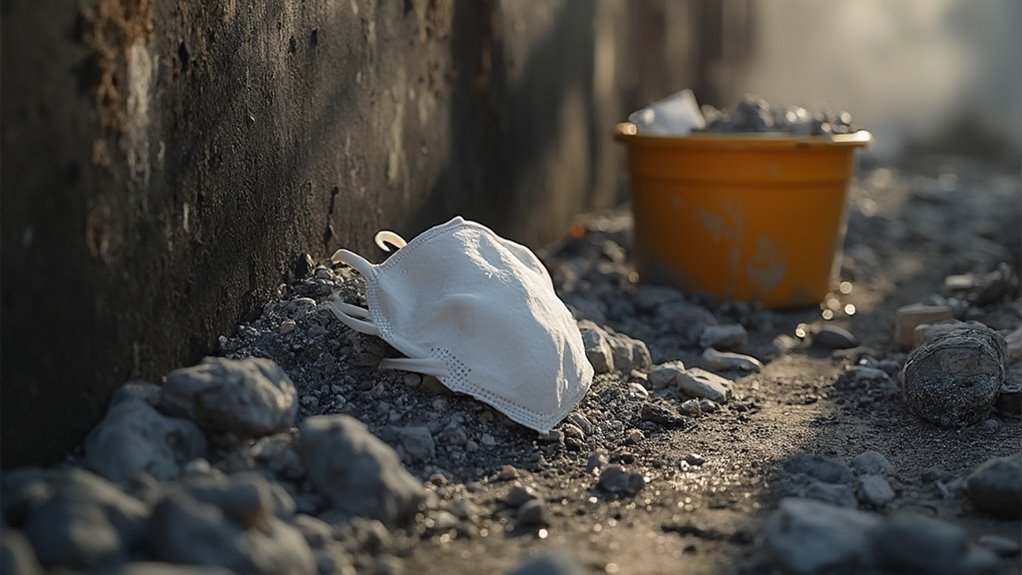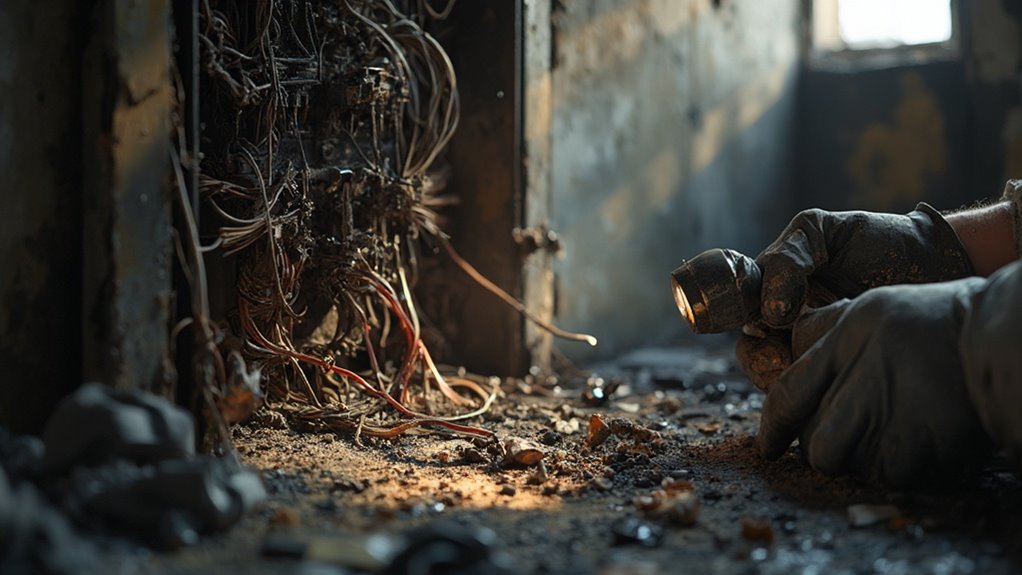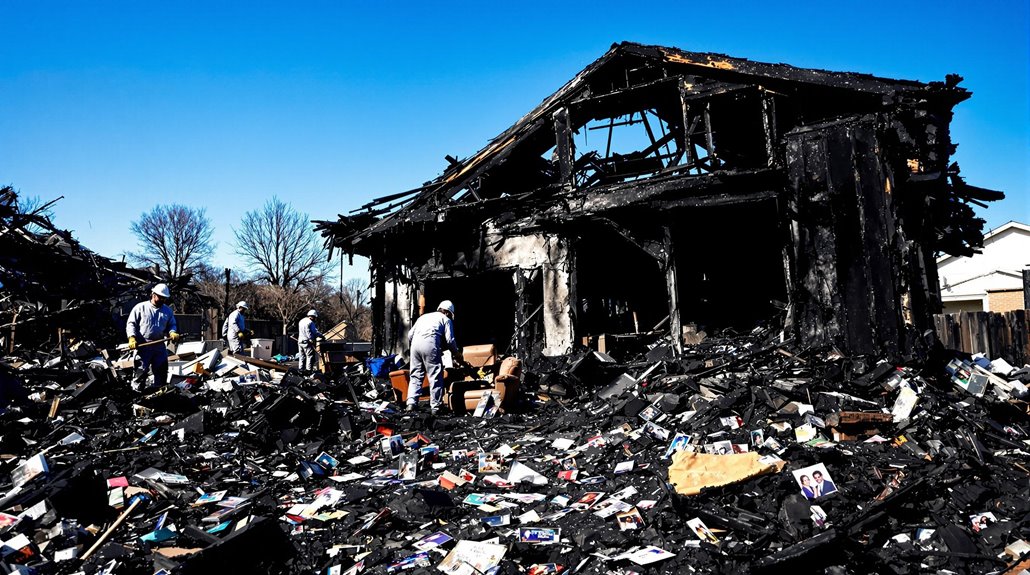Before restoration begins after fire damage, prioritize safety. Always wear Personal Protective Equipment (PPE) like gloves and masks. Turn off power and water to avoid hazards. Assess the damage thoroughly, documenting affected areas with photos and lists for insurance purposes. Don't attempt to use electrical appliances until a professional inspects them. For water damage, extract moisture using pumps and dehumidifiers. Sanitize all areas properly to prevent health risks. Be cautious with hazardous materials, and consult professionals for safe removal. There's more to weigh as you navigate this challenging process.
Key Takeaways
- Ensure safety by wearing appropriate PPE and turning off power and water supplies before entering the affected area.
- Document all damages thoroughly with photos, videos, and an inventory list for insurance claims.
- Avoid using electrical appliances and fixtures until inspected by a professional to prevent accidents.
- Remove hazardous materials safely and dispose of them separately from general debris to prevent contamination.
- Implement effective sanitization techniques post-clearance to prepare the space for restoration.
Safety Precautions

When tackling fire damage cleanup, guaranteeing your safety should be your top priority. Start by wearing appropriate Personal Protective Equipment (PPE). Use gloves to shield your hands from sharp debris and contaminants. A mask or respirator is crucial to prevent inhaling harmful particles and soot, while eye protection safeguards against debris and chemical splashes. Opt for long sleeves and pants to further protect your skin.
Before entering the area, turn off the power and water supply to minimize risks of electrical accidents or water-related hazards. Avoid using any electrical appliances until they've been inspected by a professional. Check propane and water heater tanks for damage, confirming gas supplies are likewise turned off. Emergency water removal services can be crucial in addressing any water damage quickly and efficiently.
Be aware of potential environmental and health hazards. Tripping and slipping are common in damaged areas, so tread carefully. Don't eat or drink anything in the kitchen, as contamination is likely. Promptly address any water damage to prevent mold exposure, and guarantee proper ventilation by opening windows and doors. Regular inspections are essential to ensure all areas are cleaned properly and to further minimize risks.
Finally, create a checklist of safety measures, clear the area of debris, and secure sturdy shoes to protect against sharp objects. Prioritizing these fire safety and personal safety practices can help guarantee a safer cleanup process.
Assessing the Damage
Evaluating the damage after a fire is critical for determining the necessary steps for restoration. A thorough damage assessment guarantees you understand the extent of destruction and the implications for structural stability. Start with a detailed visual inspection, documenting affected areas and noting items that are damaged or destroyed. Look for signs of structural damage, such as cracks or sagging, and use thermal imaging to identify hidden hotspots.
Follow these steps to improve your assessment:
- Non-Destructive Testing: Use tools like rebound hammers and ultrasonic pulse velocity testing to gauge material integrity without causing further damage.
- Semi-Destructive Testing: Collect concrete cores and rebar coupons for deeper analysis, evaluating how fire exposure affected material properties.
- Planning and Documentation: Create a detailed action plan based on your findings. Prioritize repairs, document everything for insurance purposes, and identify when professional help is necessary. This ensures you can engage a 24/7 rapid response team quickly to mitigate further damage.
Water Removal Techniques

Effective water removal is imperative in the aftermath of fire damage, as it helps mitigate further destruction. Begin by stopping any source of excessive water flow to prevent extra damage. Utilize powerful pumps and truck-mounted vacuum units for rapid water extraction, ensuring you remove standing water efficiently. Industrial-strength wet/dry vacuums and submersible pumps are critical for thorough water removal, especially in hard-to-reach areas.
Implement advanced techniques like moisture mapping to identify hidden pockets of moisture that could lead to mold growth or structural deterioration. Use water leak detectors to locate and eliminate all hidden sources of water, ensuring no area is overlooked. Furthermore, extract moisture from porous materials such as carpets, upholstery, and drywall to prevent long-term damage.
After initial water extraction, it's important to dehumidify the space using desiccant dehumidifiers and deploy air movers to improve air circulation. This combination speeds up the drying process and helps eliminate residual moisture in the air. By addressing water damage swiftly and effectively, you minimize health risks and protect your property from secondary damage.
Effective Drying Methods
Efficient drying methods are crucial for restoring a property after fire damage. By focusing on drying efficiency and moisture control, you can prevent secondary damage and guarantee a successful restoration.
Here are three effective drying methods to reflect upon:
- High-Powered Equipment: Utilize industrial-grade air movers and high-powered pumps for rapid water removal. Professional-grade water extractors can effectively remove moisture from carpets and flooring.
- Advanced Techniques: Implement wall cavity drying by drilling holes for airflow, and use the Rescue Mat System for hardwood floors, which creates a vacuum to draw out water vapors. Regular thermal inspections help detect hidden moisture.
- Ventilation Strategies: Confirm adequate ventilation by opening windows and using fans to improve air movement. Combining natural ventilation with mechanical methods can considerably boost drying efficiency.
Soot and Smoke Removal

When tackling soot and smoke removal, using specialized equipment is crucial for effective cleanup. You'll additionally want to incorporate odor neutralization techniques to eliminate lingering smells that often accompany fire damage. By combining these methods, you can restore your space more efficiently and thoroughly.
Specialized Equipment Use
How can specialized equipment make a considerable difference in soot and smoke removal after a fire? Utilizing the right specialized tools not only improves cleaning effectiveness but likewise safeguards health during the process. Here are three critical types of equipment to take into account:
- Industrial-Grade HEPA Vacuums: These vacuums capture fine soot particles efficiently, guaranteeing thorough cleaning while preventing the redistribution of debris. Regular equipment maintenance is crucial to keep them operating at peak performance.
- Air Scrubbers: By removing smoke particles and odors from the air, air scrubbers greatly enhance air quality. They work by filtering out harmful contaminants, making the environment safer for both technicians and occupants.
- Dehumidifiers: To prevent secondary damage, such as mold growth, dehumidifiers extract excess moisture from the air. Proper equipment maintenance guarantees they function effectively throughout the drying process.
Investing in specialized equipment not only streamlines the cleanup but likewise minimizes health risks associated with soot and smoke inhalation. Always ascertain that your tools are well-maintained to achieve ideal results in fire damage restoration.
Odor Neutralization Techniques
Odor neutralization is a crucial step in restoring spaces affected by fire damage, as lingering smoke odors can greatly impact indoor air quality and comfort. To effectively tackle these odors, you can employ a range of odor absorption techniques and advanced solutions.
| Technique | Description | Application |
|---|---|---|
| Ventilation | Open windows and use fans to circulate air. | Reduces smoke concentration. |
| Surface Cleaning | Use dry-cleaning sponges and vinegar mixtures. | Removes soot and neutralizes odors. |
| Advanced Technologies | Utilize ozone or hydroxyl generators. | Breaks down odor molecules safely. |
For smoke odor prevention, make sure to cover belongings and protect surfaces during cleanup. Natural remedies like bowls of vinegar or baking soda can likewise be effective in absorbing smoke smells. For fabrics, washing with a vinegar-detergent mix can further eliminate the odors that cling to textiles. Finally, consider activated charcoal filters in your air system to capture residual smoke odors, promoting a healthier indoor environment. By systematically applying these techniques, you can restore your space to its original condition.
Debris Clearing Process
When you're clearing debris after a fire, it's essential to identify and dispose of any hazardous materials safely. You'll need to implement effective sanitization techniques to guarantee the area is not only cleared but likewise safe for future restoration efforts. Proper handling and documentation of these processes will aid in maintaining health standards and supporting insurance claims.
Hazardous Material Disposal
Although debris clearing may seem straightforward, the disposal of hazardous materials requires meticulous attention to detail to confirm safety and compliance. Properly identifying and managing hazardous waste is crucial to protecting human health, animals, and the environment. Here's what you need to know:
- Identify Hazardous Waste: Be aware that household hazardous waste includes items like batteries, propane tanks, and paints. Toxic materials such as lead or asbestos could be present in ash and soil post-fire.
- Use Certified Crews: Only authorized government teams should handle the removal of hazardous waste. They follow strict safety protocols to mitigate risks associated with toxic materials.
- Follow Local Regulations: Verify that all hazardous waste is disposed of separately from general debris to prevent environmental contamination. Compliance with local laws is mandatory for safe and effective disposal.
These steps are essential in the debris clearing process, as improper handling of hazardous waste can lead to significant health and environmental risks. By adhering to these guidelines, you'll contribute to a safer recovery process.
Sanitization Techniques
Effective sanitization techniques are essential in the debris clearing process following fire damage. Start by removing severely damaged items to create a safe and accessible space for thorough cleaning. Categorize debris into salvageable and non-salvageable items, prioritizing restoration efforts accordingly. Clear away burnt materials and damaged furniture that pose safety risks. Always wear proper protective gear, such as N95 masks, heavy-duty gloves, and safety goggles.
After debris removal, focus on sanitizing surfaces. Use mild soap and water or specialized sanitization products for hard surfaces. Employ HEPA-filter vacuums to efficiently remove soot without spreading it to unaffected areas. For delicate materials, consider non-abrasive methods like soda blasting to prevent damage.
Ventilate the area to reduce airborne particles, and test cleaning solutions on small sections to avoid further damage. Remember that the environmental impact of your chosen sanitization products matters; opt for eco-friendly options whenever possible. Finally, deep cleaning services for upholstery and ventilation systems will help eliminate lingering odors, ensuring your space is not only clean but also safe for habitation.
Sanitizing Affected Areas

Sanitizing affected areas after fire damage is crucial for restoring safety and comfort in your space. Effective sanitization methods not only help eliminate harmful residues but likewise improve air quality. Here are three critical steps to follow:
- Personal Protective Equipment: Always wear gloves, long-sleeved clothing, goggles, and an N95 mask to protect against ash, soot, and cleaning chemicals. Ensuring chemical safety is paramount.
- Initial Cleanup: Begin by removing burned debris to mitigate odors and further damage. Use dry chemical sponges to lift soot from surfaces, and install dehumidifiers if water was used during firefighting efforts.
- Surface Cleaning: Different surfaces require tailored approaches. For high-oxygen fire damage, utilize dry sponges along with low-alkali detergents. Conversely, low-oxygen damage calls for high-alkali detergents and warm water. Always rinse thoroughly to remove any residues.
Repairing Structural Damage
After thoroughly sanitizing the affected areas, the next step is to address any structural damage caused by the fire. Begin with an extensive structural evaluation to gauge the extent of damage and identify safety hazards. Document your findings with detailed notes and photographs, as this will assist in creating a restoration plan and support any insurance claims.
Inspect for signs of structural damage, evaluating components as mildly, moderately, severely damaged, or dangerous. Remove any compromised concrete to guarantee a stable base for repairs and replace weakened reinforcement to maintain structural integrity. If necessary, prop the structure to support it during the repair process.
Utilize effective reinforcement techniques such as cement-based slurry injection for fire-damaged concrete, or epoxy injection and steel wire mesh with epoxy resin wrapping for more severe cases. Your goal is to reinstate the original form while guaranteeing adequate structural capacity and fire resistance.
Lastly, conduct a thorough final inspection to confirm that all repairs meet quality and safety standards. Address any remaining structural concerns and verify that the property is safe for occupation before concluding the restoration process.
Electrical System Evaluation

Conducting a thorough evaluation of the electrical system is crucial following fire damage, as it guarantees both safety and functionality. You need to engage a licensed electrician or a trained fire damage specialist to conduct this assessment. This confirms that all potentially hazardous issues are identified and addressed properly.
Here are three critical steps to follow during the evaluation:
- Inspect Visible Damage: Look for charred or melted wires, damaged outlets, and compromised fuse boxes. This assists in identifying immediate risks.
- Utilize Diagnostic Tools: Employ advanced tools like thermal imaging cameras. These can reveal hidden issues that might not be visible to the naked eye.
- Prioritize Safety First: Turn off all electrical sources before inspection to prevent shocks or further fires. Confirm structural integrity before entering the building.
After assessment, consider wiring upgrades to replace burned wires and improve electrical safety. Confirm all repairs comply with local building codes and national safety standards. Remember, ignoring electrical system evaluation could lead to severe consequences, including secondary fires. Prioritize safety and functionality in your restoration efforts.
Insurance and Funding Considerations
When dealing with fire damage, understanding your insurance coverage limits is crucial for effective recovery. You should document all damages thoroughly, as this will support your claim and guarantee you receive the appropriate compensation. By being proactive in these areas, you'll streamline the claims process and better navigate the financial implications of restoration.
Understanding Coverage Limits
Understanding coverage limits is essential for maneuvering the complexities of fire damage claims and ensuring you're adequately protected. Your insurance policy outlines the maximum amount the insurer will pay for damages, and it's imperative to grasp these limits to avoid unexpected costs.
Here are three key considerations for effective coverage evaluation:
- Assess Your Assets: Regularly evaluate the value of your home and personal belongings. This helps determine if your coverage limits are sufficient to cover potential damages.
- Understand Exclusions: Familiarize yourself with what your policy excludes. Fire damage from negligence or intentional acts often isn't covered, which can leave you financially vulnerable.
- Engage in Policy Negotiations: Don't hesitate to discuss your coverage limits with your insurance agent. They can offer guidance on adjusting your policy to better fit your needs, ensuring you're not left underinsured.
Documenting Damages Properly
How can you guarantee your fire damage claim is processed smoothly? Proper damage documentation is vital. Start by taking numerous photos and videos of the affected areas, capturing wide shots and close-ups from various angles. Confirm you document all structural damage, including walls, ceilings, and floors, in addition to any smoke or water damage. Pay attention to electrical systems, but avoid direct contact for safety.
Next, create a detailed inventory list of all damaged or destroyed items. Include descriptions, quantities, and estimated values, and gather receipts or proof of ownership for valuable possessions. It's fundamental to note purchase dates and categorize items, like clothing or electronics, for clarity.
Don't forget to secure and store evidence. Save samples of damaged materials when safe, collect documentation like fire reports, and maintain a log of all communications with your insurance company. Track additional expenses incurred because of the fire, including temporary housing and repair costs. Request multiple quotes from contractors to substantiate your claims. By following these steps, you improve your chances of a seamless claims process and confirm you receive the funding you deserve.
Conclusion
In the aftermath of fire damage, balancing urgency with caution is vital. While it's tempting to rush into restoration, taking the time to assess and guarantee safety can prevent further complications. Effective cleanup not only restores your space but likewise safeguards your health. Remember, addressing both visible damage and hidden issues like soot or moisture is key to a thorough recovery. By following the do's and don'ts, you pave the way for a successful restoration and a safer environment.







